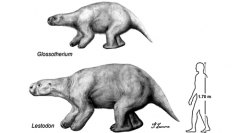

 Comptes Rendus Palevol
11 (8) - Pages 549-554
Comptes Rendus Palevol
11 (8) - Pages 549-554Recently discovered stapes of Pleistocene South American ground sloths of the genera Lestodon and Glossotherium are studied. Available body mass estimates are larger for Lestodon (4100 kg) than for Glossotherium (1500 kg), reflecting the obvious difference in the overall size of the skull and other bones. However, as previously reported, the absolute size of incus and malleus is very similar in both genera. In a previous work, the frequency range of Glossotherium (from 44 Hz to 15,489 Hz) was estimated quantitatively from well-preserved tympanic ring dimensions. For the first time the frequency ranges of hearing in both genera are estimated by a method based on the footplate area of the stapes. The obtained frequency ranges are consistent with the previous estimation for Glossotherium and are similar in both genera, giving evidence of a frequency range of hearing independent of body size in this group of mammals. Some possible paleobiological implications of the results may include adaptation to some specific sound source, fossoriality, or long-range communication.
Ground sloths, Pleistocene, South America, Hearing, Long-range communication